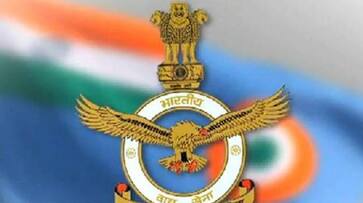IAF used air power at the height of 32,000 feet for the first time. From identifying Pakistani troops and Mujahideens to interdiction, all the actions were performed well by pilots and engineers despite being trained for just one week
New Delhi: It was around the same time 20-years-ago when Indian forces launched a counter strike on Pakistani troops during the Kargil war. The armed forces launched Operation Vijay and to assist them in the air the Indian Air Force (IAF) carried out Operation Safed Sagar, which became a crucial move that helped the Indian forces to win the war. It was the first large scale use of air power in the Jammu and Kashmir region since the Indo-Pakistani War of 1971.
The brave warriors of the Indian Air Force played a massive role in assisting the armed forces in crushing Pakistani insurgents who had made their bases in peaks of Kargil sector of Jammu and Kashmir. The Operation Safed Sagar by IAF started at 6:30 am on May 26, 1999, when they launched the first strike on the Pakistani posts. Series of air strikes over the icy heights of the Kargil sector was a herculean job. IAF pilots not only faced hostile conditions like temperature and high altitude but also had a strict order not to cross the Line of Control (LoC).
#RememberingKargil #OpSafedSagar Morning of 26 May 1999: IAF commenced air ops by attacking enemy positions & supply lines. First strike was launched at 0630hrs by MiG-21, MiG-27ML & MiG-23BN fighters. pic.twitter.com/CMPb2cYv8C
— Indian Air Force (@IAF_MCC) May 26, 2019
IAF used air power at the height of 32,000 feet for the first time. From identifying Pakistani troops and Mujahideens to interdiction, all the actions were performed well by pilots and engineers despite being trained for just one week. According to experts, Operation Safed Sagar was a turning point in the history of military aviation.
During the operation Squadron Leader Ajay Ahuja of the 17 Squadron of Mig-21s, the Golden Arrows based at Bathinda, made a supreme sacrifice when he was shot down near the border. He was posthumously awarded the Vir Chakra for gallantry. Flight lieutenant Nachiketa's jet faced mechanical problems, and the IAF later said that the MiG 27s' engine had stopped. Left with no option, flight lieutenant Nachiketa had to eject, and while others attempted to locate him, they eventually headed back because their jets were low on fuel.
#RememberingKargil #OpSafedSagar Twenty years ago today Indian Air Force was given the GO AHEAD to launch aerial counteroffensive in the #KargilWar. This decisive step would go on to be the enemy's nemesis and the beginning of the end of his occupation.https://t.co/gaqpQ7SEb7 pic.twitter.com/nCky1MTlPW
— Indian Air Force (@IAF_MCC) May 25, 2019
Meanwhile, squadron leader Ahuja led a two-jet deployment of Mig-21s of Squadron 17 Golden Arrow with a photo reconnaissance mission to assess the damage caused by the four Mig 27s on the insurgents and their stockpiles earlier in the day. He was informed that flight lieutenant Nachiketa's jet had crashed and that he had ejected from it. When the MiG 21s tasked with Battle Damage Assessment reached Muntho Dhalo, insurgents - still on alert from the previous strike - fired missiles and one of these hit Squadron Leader Ahuja's jet. He had managed to eject, but by then, he had reached over the Pakistan Brigade HQ. He was taken prisoner by Pakistani forces and was tortured and killed.
When his mortal remains were returned to India, it was ridden with bullet wounds. The cold-blooded murder of Sqn Ldr Ahuja and the capture of Flt Lt Kambampati Nachiketa whose jet suffered a flame-out led to an unprecedented wave of public anger and also triggered an angry response from the international community towards Pakistan.
Flight lieutenant Nachiketa too had been captured by Pakistani forces, and while he was returned to India through the Wagah border eventually - on June 3, he went on to say what he went through while in captivity cannot be described in words. He had added that death would have been better.
Interestingly, Ahuja's squadron was under the command of then Wg Cdr B S Dhanoa who happens to be the current Chief of Air Staff. IAF lost three of its officers and two airmen in the conflict. The force was awarded two Vir Chakras and 23 Vayu Sena Medals for its role in the war.
As many as 17 IAF squadrons relentlessly carried out dangerous photo reconnaissance and strike missions during the war. The skilful pilots of the IAF engaged ground targets at high altitudes that were well shielded by Pakistan's air defence weapons. No exercises or practice runs had been carried out by IAF in this area or even at these heights.
IAF inflicted serious damage to Pakistan's intruder posts, material and supply dump after exhaustive sorties. Amid all this, its MiG-29 air superiority fighters also kept Pakistan's US-built F-16s in check with reports mentioning missile locks on the enemy jets by IAF MiGs. IAF and the Army worked in close coordination, and air power inflicted heavy damages on the intruders, apart from reducing casualties on the ground and playing a pivotal role in while wiping off the enemy forces from Dog Hill and Tiger Hill.
This is the 20th year of the Kargil War, one of India's fiercest wars, that is etched with memories of the brave sacrifices made by the Indian soldiers. Kargil Vijay Divas is celebrated on July 26 every year.
Last Updated May 27, 2019, 5:02 PM IST









![Salman Khan sets stage on fire for Anant Ambani, Radhika Merchant pre-wedding festivities [WATCH] ATG](https://static-gi.asianetnews.com/images/01hr1hh8y86gvb4kbqgnyhc0w0/whatsapp-image-2024-03-03-at-12-24-37-pm_100x60xt.jpg)
![Pregnant Deepika Padukone dances with Ranveer Singh at Anant Ambani, Radhika Merchant pre-wedding bash [WATCH] ATG](https://static-gi.asianetnews.com/images/01hr1ffyd3nzqzgm6ba0k87vr8/whatsapp-image-2024-03-03-at-11-45-35-am_100x60xt.jpg)


